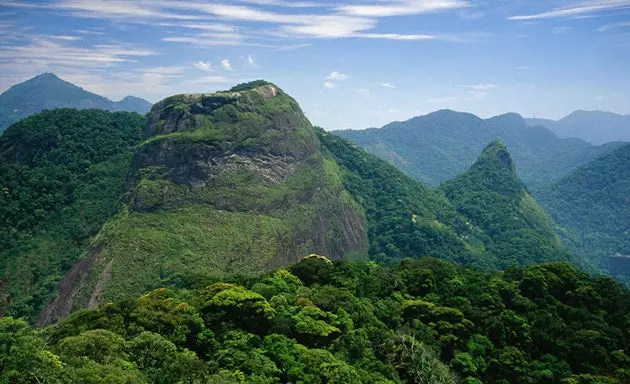
Aerial view of Tijuca Rio de Janeiro National Park.
In the heart of Rio appears the Tijuca National Park, a small earthly paradise that extends 39 square kilometers through the hills and coastal mountains that cross the city, making it the largest urban jungle in the world. It is home to innumerable animal and plant species, its greatest attraction being the different waterfalls and natural springs that dot its topography. , being the cascatinha do Taunay, with a 30 meter jump, the most accessible of them. The natural gateway to Tijuca is Barão D'Escragnole, Alto de Boa Vista.
The park houses some of the most significant rock formations in the city, such as Pedra da Gávea, the largest coastal monolith in the world, and Corcovado, where Christ the Redeemer stands. There are many winding paths that run through the Tijuca Forest, all divided into itineraries of greater or lesser duration, the longest being one day, with visits to Tijuca Peak and Pedra da Gávea. Another option is to travel it by car through the roads that connect the neighborhoods of Santa Teresa, Jardim Botånico and Barra da Tajuca. In the visitor center in Plaça Afonso Viseu they have maps of all the walking itineraries and roads.
There are three viewpoints in the Tijuca National Park, the most famous and visited of which is the one that stands at the base of Christ the Redeemer. The other two go into the Tijuca forest, the Mirante Dona Marta that offers views over the coastal neighborhood of Botafogo, with the Sugar Loaf in the background, and the Mirante Andaime Pequeno, which has impressive views over the Jardim Botånico neighborhood and the Christ redeemer. It is not advisable to go to them after 5:00 pm, especially to the Dona Marta viewpoint, since they are areas with some insecurity.
Tijuca is the largest urban jungle in the world, because it is respected by the inhabitants of Rio , although it was not always like this, since when the Portuguese arrived in these areas they cut down a good part of the Tijuca to plant sugar and coffee, something that caused great floods in the first years of colonial rule, for this reason in 1861 Pedro II commissioned its reforestation, for which 13 long years were needed.
Among the constructions that are scattered along the Tijuca, the mayrink chapel , dating from 1863, and You Aeschylos , the favorite restaurant for wealthy cariocas to have lunch on Sundays, as it has a privileged location. In 1991 Tijuca was declared a UNESCO Biosphere Reserve.
Map: See map
Address: Visitor Center: Praça Afonso Viseu, Tijuca Rio de Janeiro See map
Telephone: 00 55 21 2492 2253
Price: Free
Schedule: Every day from 8:00 a.m. to 7:00 p.m.
Guy: Parks and gardens
